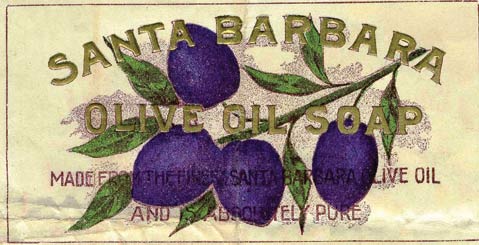Los Olivos
History of Olive Cultivation in S.B.

The Franciscans of the mission system introduced the olive to Alta California in the late 1700s, bringing the first seeds with them from Mexico. Olives were initially a low-priority agricultural item, as the padres first had to establish basic foodstuff crops. Eventually, the Santa Barbara area proved quite conducive to the propagation of olives and the production of olive oil.
For a number of years after the founding of the Santa Barbara Mission in 1786, the padres got their supply of olive oil from Mission San Diego, which was founded in 1769 and had developed significant olive orchards. By the late 1820s, the Santa Barbara Mission had developed its own thriving olive orchards. Los Olivos Street is a reminder of the once flourishing olive cultivation carried out at the Old Mission.
Although the cured fruit itself was consumed, olives were grown primarily for the oil. At the mission, Chumash laborers pulverized the fruit, and the oil was filtered through finely woven cloth. The oil was used not only in cooking but also for medicinal purposes and as a general-purpose lubricant. It was also used sometimes as an illuminant, although tallow rendered from cattle was preferred.
The mission remained the center of a rather modest olive industry until Ellwood Cooper arrived on the South Coast in 1870. Cooper became one of the major commercial olive growers in California. By the late 19th century, his olive orchards in the Goleta Valley contained more than 12,000 trees, and he had become one of the top olive oil producers in the nation, enjoying a reputation for the purity of his product. Cooper was the key figure in a South Coast olive industry that was one of the most important in the country in the late 1800s.
The late 1800s were the heyday of the olive industry in this area. In addition to Cooper, Peveril Meigs’s olive mill on the Mesa produced an oil of exceptional purity. William P. Gould formed a company in 1893 to construct an olive mill to produce oil from the olives harvested on his Montecito ranch. He marketed the oil locally and the mill also turned out oil by-products such as olive oil candy and olive oil soap. Local demand never quite met expectations, and the company shut down in 1905. Olive Mill Road is named after Gould’s venture.
Stiff European competition began to adversely impact the California olive industry in the early 1900s. A botulism scare in 1919 dealt an additional blow to the statewide industry. Although olives continue to be grown in central California and there continues to be a small area industry, the great days of South Coast olive production have passed.
In 1919, the city council approved the planting of olive trees along Canal Street, which was later renamed Olive Street. The idea was to harvest the fruit, the sale of which would go toward various city park projects; nothing much ever came of this scheme. Santa Barbara Olive Company harvested the trees for a short period in the early 1990s, but this soon came to a halt.
The legacy of Santa Barbara’s olive industry today may be seen in the trees that line some streets, in street names, and in a small number of area companies that produce gourmet olives and olive oil. The olive has left a lasting mark on the South Coast.



